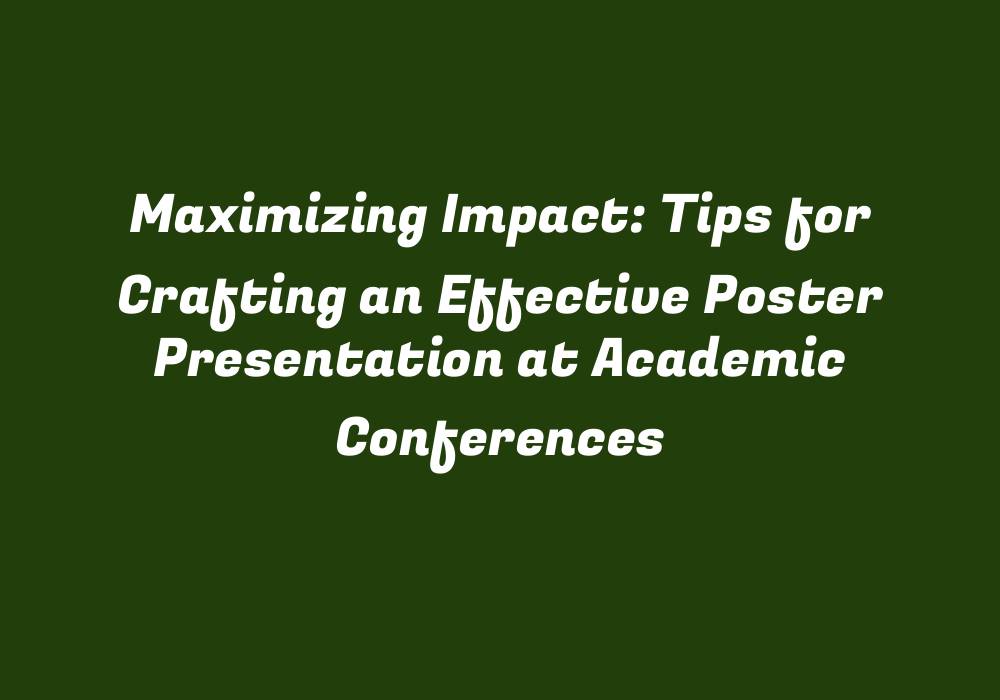Introduction
Poster presentations have become a crucial part of academic conferences. They are often used to communicate your research findings and ideas in an easily understandable manner. Crafting an impactful poster presentation can be challenging, but with the right tips and tricks, you can maximize its effectiveness. In this article, we will discuss various strategies that can help you create a successful poster presentation for academic conferences.
Visual Clarity
Choose an appropriate design: Selecting the right layout is essential to making your poster easy to comprehend and visually appealing. Keep it simple with clear headings, ample white space, and well-organized information. Use color schemes that are pleasing to the eye and ensure they complement each other.
Use appropriate fonts: Choose legible fonts for your poster text. Typically, sans serif fonts like Arial or Helvetica work well. Ensure that all text is clear and large enough to be read from a distance without losing context. Maintain consistency in your font size, styles, and colors throughout the presentation.
Create a strong visual hierarchy: Arrange your poster’s elements logically so that it can be easily scanned by viewers. Organize them into different sections using headers, subheadings, and bullet points to make navigating through the information more manageable.
Concise Content
Focus on key messages: Stick to the main ideas you want your audience to take away from your poster presentation. Identify the most important aspects of your research and emphasize them in clear and straightforward language. Avoid including unnecessary details that might distract from your primary objectives.
Use concise text: Keep your descriptions brief yet informative, allowing viewers to grasp the essence of your research findings. Limit each section to a few sentences or short paragraphs, ensuring that they do not exceed the provided space.
Highlight the significance of your work: Make it clear why your research is significant and how it contributes to the field of study. Provide information on relevant background knowledge, methods used in your research, and any potential implications for future work.
Engaging Visuals
Use appropriate images: Incorporate visual elements that help illustrate your findings or support your key messages. Choose high-quality images related to your topic, ensuring they align with the content of your poster. Avoid using generic stock photos or images unrelated to your research.
Create informative graphs and tables: Use data visualization techniques to make complex information more digestible for your audience. Create clear charts, graphs, or tables that convey key findings in a concise manner. Remember to include appropriate labels and scale bars to help readers understand the data.
Emphasize relevant statistics: When possible, highlight important numerical data through well-designed graphs and tables. Provide context by stating where these figures come from or how they were calculated, making it easier for your audience to comprehend the significance of your research findings.
Effective Communication
Create a compelling Design an attention-grabbing title that captures the essence of your poster presentation and encourages viewers to learn more. Keep it concise, yet engaging, so it piques their interest in exploring your research further.
Use bullet points: List key points or results for each section of your poster using bullet points to make them easily noticeable by the audience. This helps guide them through your findings and provides an overview of your research’s highlights.
Emphasize clarity in your text: Make sure that your wording is straightforward and easy to understand, avoiding jargon or overly complex language. Remember to consider the audience’s background knowledge and adapt the content accordingly so they can easily grasp your main points.
Interactive Engagement
Prepare for questions: Be prepared to address potential queries from attendees about your research or methods. Keep in mind that you might encounter varying levels of understanding and knowledge among viewers, so tailor your explanations accordingly.
Encourage discussion: Create opportunities for interaction by incorporating a questionnaire, an interactive element like a poll, or a discussion prompt related to your research. These elements can foster meaningful conversations and help attendees connect with your work on a deeper level.
Promote engagement through networking: Take advantage of the conference’s networking opportunities by sharing your poster’s location with other researchers and attendees. Engage in informal chats to build connections, share knowledge, and gather feedback on your work.
Conclusion
Crafting an effective poster presentation for academic conferences requires careful planning, a well-structured design, concise content, engaging visuals, clear communication, and interactive engagement. By following these tips, you can maximize the impact of your research and leave a lasting impression on attendees.
Remember to continually revise and refine your poster presentation before presenting it at conferences. This will help ensure that your work is both informative and easily understood by your audience.
